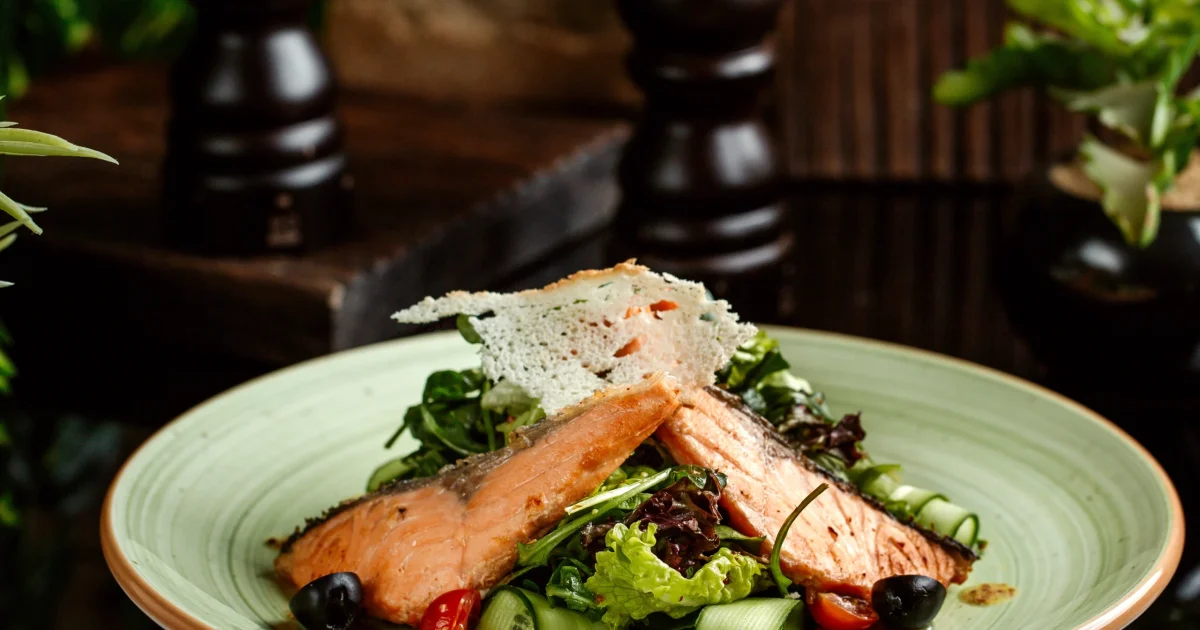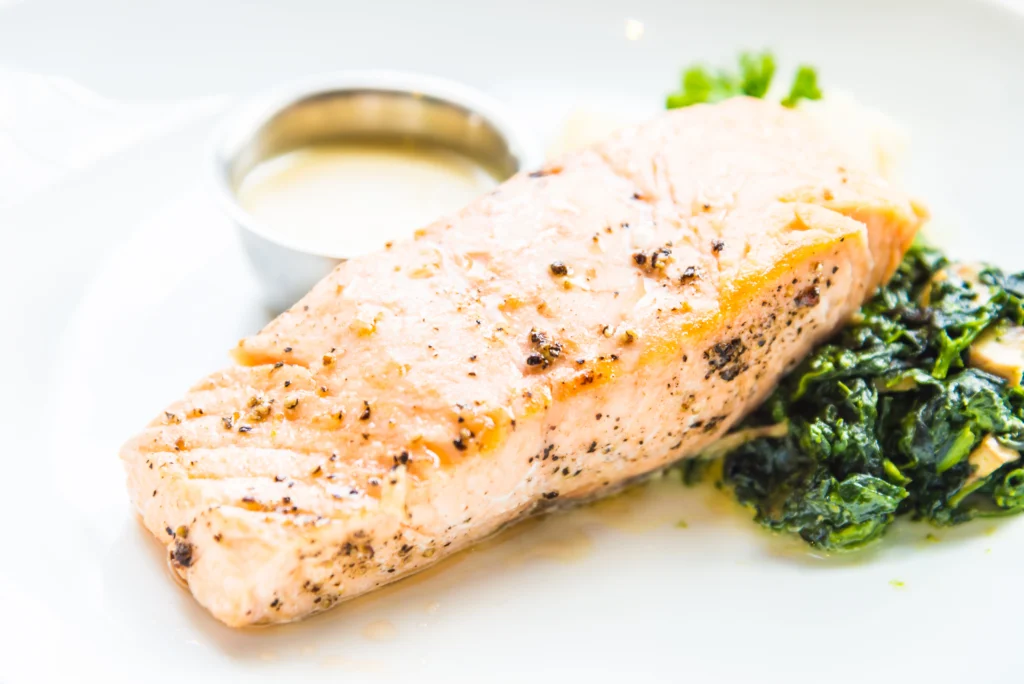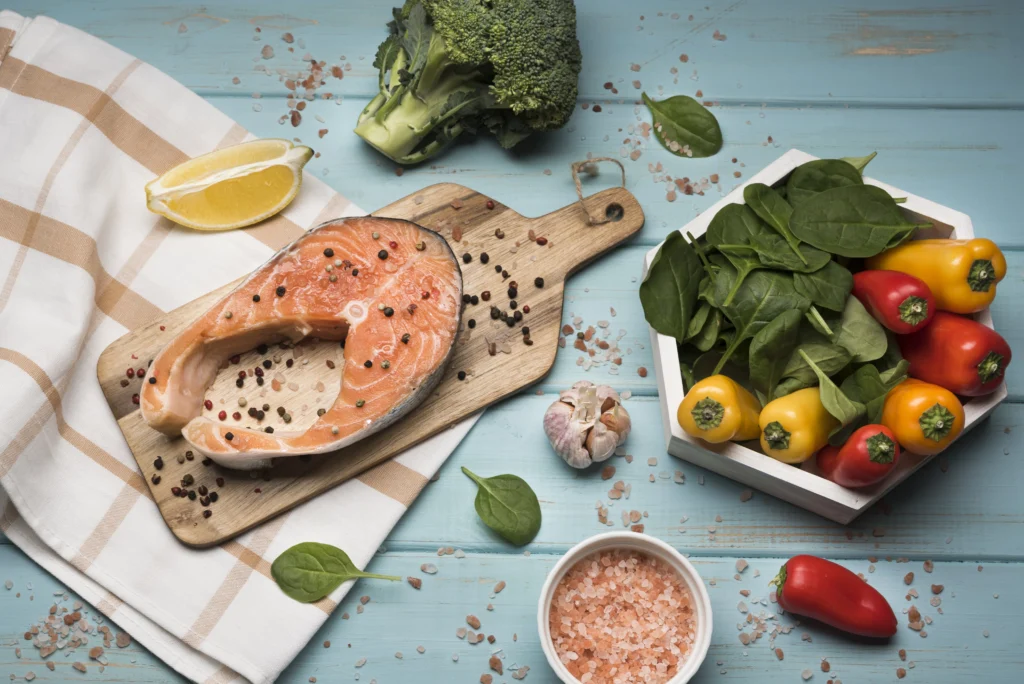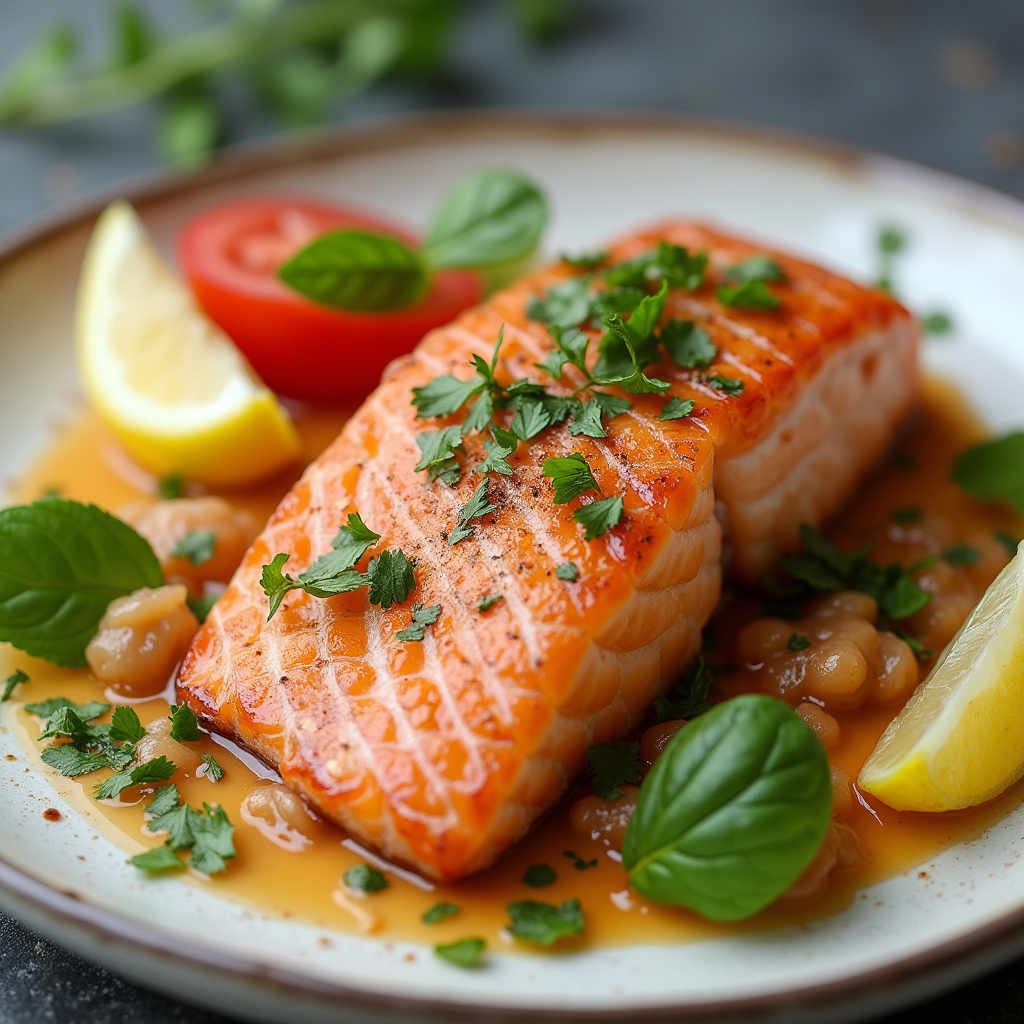
There’s something truly magical about the moment when you first taste a perfectly cooked piece of salmon alongside vibrant, nutrient-packed spinach. I still remember the evening I discovered this combination—exhausted after a long workday, wanting something both nourishing and simple. What started as a rushed dinner experiment became my go-to solution for balancing health and flavor without spending hours in the kitchen. If you’ve been searching for meals that are both nutritious and delicious, this powerful pairing might just change your weeknight dinner routine forever.
Why Salmon and Spinach Should Be Your Healthy Meal Heroes
Few food combinations offer the nutritional powerhouse status that salmon and spinach bring to your table. Salmon delivers exceptional omega-3 fatty acids that support heart and brain health, while providing high-quality protein crucial for muscle maintenance. Meanwhile, spinach contributes essential iron, folate, and vitamins that complement salmon’s nutritional profile perfectly.
Beyond their impressive nutritional credentials, these ingredients stand out for their remarkable cooking versatility. Whether you have fifteen minutes or forty-five, both adapt beautifully to quick-cooking methods or more elaborate preparations. Even better? Both ingredients remain available year-round, with frozen options maintaining most of their nutritional integrity when fresh isn’t accessible.
For those following specific eating patterns—whether Mediterranean, keto, or simply focused on increasing protein intake—this dynamic duo fits seamlessly into virtually any healthy eating approach. The combination satisfies hunger effectively while keeping calories reasonable, making weight management considerably more pleasant than with typical “diet foods.”
7 Essential Kitchen Tools for Perfect Salmon and Spinach Meals
Before diving into recipes, setting yourself up with the right kitchen equipment makes preparing salmon and spinach dishes significantly more enjoyable. Consider these seven tools essential for your culinary success:
- Non-stick skillet or cast iron pan – The ideal vessel for achieving that coveted crispy salmon skin while preventing sticking
- Baking sheet with parchment paper – Perfect for oven-roasted salmon that cooks evenly without creating difficult cleanup
- Fish spatula – The thin, flexible edge helps lift delicate fish without breaking fillets
- Instant-read thermometer – Eliminates guesswork by confirming perfect doneness every time
- Steamer basket – Preserves spinach’s nutrients better than boiling while creating ideal texture
- Quality chef’s knife – Makes quick work of chopping spinach and preparing aromatics
- Microplane – Essential for adding fresh citrus zest that brightens any salmon dish
These tools needn’t break your budget—even basic versions significantly enhance your cooking experience and contribute to more consistent results.
Quick-Start Guide: Mastering Basic Salmon and Spinach Cooking Techniques
Perfect Pan-Seared Salmon Method
Mastering this fundamental technique transforms you into a confident seafood cook. Begin by patting salmon fillets completely dry with paper towels—this single step dramatically improves browning. Season generously with salt and freshly ground pepper just before cooking, not earlier, as salt draws out moisture.
Heat your pan over medium-high heat until droplets of water sizzle and evaporate immediately upon contact. Add a tablespoon of high-heat oil (avocado works brilliantly), then place salmon skin-side down. The secret most home cooks miss? Resist the urge to move the fillet prematurely. Allow it to cook undisturbed for about four minutes until the skin crisps beautifully and releases naturally from the pan.
Spinach Preparation Methods
Spinach preparation presents fewer technical challenges but benefits tremendously from proper handling. When using fresh spinach, wash thoroughly in cold water, then spin completely dry. Excess moisture creates steam that can lead to soggy rather than sautéed results.
When using frozen spinach, thaw completely then squeeze thoroughly in a clean kitchen towel to remove excess moisture. This step might seem tedious but dramatically improves texture in creamy dishes especially.
5 Easy Salmon and Spinach Recipes for Busy Weeknights
15-Minute Garlic Lemon Salmon with Sautéed Spinach
Ingredients
| Salmon Ingredients | Quantity | Spinach Ingredients | Quantity |
|---|---|---|---|
| Salmon fillets | 4 (6 oz each) | Fresh spinach | 8 cups |
| Garlic cloves | 3 minced | Olive oil | 1 tbsp |
| Lemon | 1 whole | Garlic cloves | 2 minced |
| Olive oil | 2 tbsp | Salt | To taste |
| Salt and pepper | To taste | Red pepper flakes | ¼ tsp |
Step-by-Step Instructions
- Pat salmon fillets dry with paper towels, then season liberally with salt, pepper, and half the minced garlic.
- Heat a large skillet over medium-high heat, add olive oil, and place salmon skin-side down.
- Cook undisturbed for 4 minutes until skin crisps, flip once, and cook 2-3 minutes more.
- Remove salmon to a plate and loosely tent with foil.
- In the same pan, add remaining oil and garlic, cooking until fragrant (about 30 seconds).
- Add spinach in batches, turning with tongs until just wilted but still bright green.
- Season spinach with salt and red pepper flakes, then divide between four plates.
- Top each spinach portion with a salmon fillet, squeeze fresh lemon over everything, and serve immediately.
This recipe epitomizes weeknight efficiency without sacrificing flavor or nutrition. The bright lemon cuts through the richness of salmon perfectly, while garlic connects both components harmoniously.
One-Pan Baked Dijon Salmon with Spinach and Cherry Tomatoes
Ingredients
| Main Ingredients | Quantity | Seasoning Ingredients | Quantity |
|---|---|---|---|
| Salmon fillets | 4 (6 oz each) | Dijon mustard | 2 tbsp |
| Baby spinach | 6 cups | Honey | 1 tbsp |
| Cherry tomatoes | 1 pint | Garlic powder | 1 tsp |
| Olive oil | 3 tbsp | Italian herbs | 2 tsp |
| Salt and pepper | To taste | Lemon | 1 whole |
Step-by-Step Instructions
- Preheat your oven to 400°F and line a rimmed baking sheet with parchment paper.
- In a small bowl, whisk together Dijon mustard, honey, 1 tablespoon olive oil, garlic powder, and half the Italian herbs.
- Toss cherry tomatoes with 1 tablespoon olive oil, remaining herbs, salt, and pepper, then arrange on one side of the baking sheet.
- Place salmon fillets in the center of the sheet, brush generously with the Dijon mixture.
- Roast for 10 minutes, then remove from oven.
- Toss spinach with remaining olive oil and arrange around salmon fillets.
- Return to oven for 5 minutes until salmon reaches desired doneness and spinach wilts.
- Squeeze fresh lemon juice over everything before serving.
The brilliance of this recipe lies in its simplicity and minimal cleanup. The Dijon mixture caramelizes slightly during roasting, creating a delectable glaze that complements both the salmon and vegetables.
Creamy Salmon and Spinach Pasta (30-Minute Meal)
Ingredients
| Pasta Base | Quantity | Sauce Ingredients | Quantity |
|---|---|---|---|
| Pasta of choice | 12 oz | Heavy cream | 1 cup |
| Salmon fillets | 1 lb | Parmesan cheese | ½ cup grated |
| Baby spinach | 5 cups | Garlic cloves | 3 minced |
| Olive oil | 2 tbsp | Lemon zest | 1 tsp |
| Salt and pepper | To taste | Fresh dill | 2 tbsp chopped |
Step-by-Step Instructions
- Bring a large pot of salted water to boil and cook pasta according to package directions until al dente.
- Meanwhile, season salmon with salt and pepper, then cook in olive oil over medium-high heat for 4 minutes per side.
- Remove salmon to a plate and break into large flakes with a fork.
- In the same pan, sauté garlic until fragrant, about 30 seconds.
- Add heavy cream and bring to a gentle simmer, then stir in Parmesan cheese until melted.
- Add lemon zest, dill, and spinach, stirring until spinach wilts.
- Fold in the salmon flakes and drained pasta, tossing gently to combine.
- Serve immediately with additional Parmesan if desired.
This dish transforms ordinary pasta night into something special without requiring complicated techniques. The creamy sauce brings everything together while the lemon zest and dill provide brightness that prevents heaviness.

Salmon and Spinach Breakfast Egg Cups (Make-Ahead Option)
Ingredients
| Base Ingredients | Quantity | Seasoning | Quantity |
|---|---|---|---|
| Eggs | 8 large | Salt and pepper | To taste |
| Smoked salmon | 6 oz chopped | Dried dill | 1 tsp |
| Fresh spinach | 2 cups chopped | Onion powder | ½ tsp |
| Feta cheese | ¼ cup crumbled | Red pepper flakes | ¼ tsp |
| Olive oil spray | For muffin tin | Fresh chives | 2 tbsp chopped |
Step-by-Step Instructions
- Preheat oven to 375°F and generously spray a 12-cup muffin tin with olive oil spray.
- Whisk eggs in a large bowl with salt, pepper, dried dill, and onion powder.
- Sauté spinach briefly until just wilted, then squeeze out excess moisture.
- Divide spinach, chopped smoked salmon, and feta cheese evenly among muffin cups.
- Pour egg mixture over the fillings, leaving ¼-inch space at the top of each cup.
- Bake for 15-18 minutes until eggs are set but not overcooked.
- Let cool slightly before removing from tin, then garnish with fresh chives.
- Store refrigerated for up to three days and reheat gently in microwave when ready to eat.
These portable protein powerhouses revolutionize breakfast meal prep. By changing your morning routine to include these nutrient-dense egg cups, you’ll start your day with balanced energy rather than the typical carbohydrate crash.

Asian-Inspired Salmon and Spinach Rice Bowls
Ingredients
| Bowl Base | Quantity | Sauce Ingredients | Quantity |
|---|---|---|---|
| Salmon fillets | 1 lb | Soy sauce | 3 tbsp |
| Cooked brown rice | 3 cups | Honey | 2 tbsp |
| Baby spinach | 4 cups | Rice vinegar | 1 tbsp |
| Carrots | 2 julienned | Sesame oil | 2 tsp |
| Avocado | 1 sliced | Ginger | 1 tbsp grated |
| Green onions | 4 chopped | Garlic | 2 cloves minced |
Step-by-Step Instructions
- Whisk together all sauce ingredients in a small bowl.
- Heat a non-stick skillet over medium-high heat, add salmon fillets and pour half the sauce over them.
- Cook for 4 minutes, flip, and cook 3-4 minutes more until desired doneness.
- Remove salmon and set aside, then add spinach to the same pan with a splash of water.
- Cover briefly until spinach wilts, about 1 minute.
- Assemble bowls: brown rice on bottom, spinach, julienned carrots, and salmon.
- Top with sliced avocado, green onions, and drizzle with remaining sauce.
This globally-inspired bowl brings tremendous flavor while maintaining the nutritional integrity that makes salmon and spinach so valuable. The combination of textures—crisp vegetables, tender salmon, and creamy avocado—creates a satisfying meal experience.
Nutritional Benefits of Salmon and Spinach Combination
Salmon’s Nutritional Profile
Wild-caught salmon represents one of nature’s most perfect protein sources. Beyond its impressive 22 grams of protein per 4-ounce serving, salmon delivers extraordinary levels of omega-3 fatty acids—specifically EPA and DHA—forms that your body utilizes most efficiently. These compounds reduce inflammation throughout your body, potentially lowering risk factors for heart disease and supporting brain health.
Spinach’s Nutritional Power
Spinach complements salmon perfectly by providing nutrients the fish lacks. Its exceptional iron content supports oxygen transport throughout your body, while its abundance of vitamin K regulates proper blood clotting and supports bone health. The folate in spinach proves essential for DNA synthesis and repair—particularly important during periods of growth or healing.
How This Combination Supports:
Together, salmon and spinach create a synergistic effect greater than either food alone. Their combined nutrients support:
Heart health: Omega-3s from salmon reduce triglycerides and inflammation, while spinach’s nitrates may help regulate blood pressure.
Brain function: DHA from salmon constitutes a structural component of brain tissue, while spinach’s antioxidants combat oxidative stress that can impair cognitive function.
Immune system: Vitamin D from salmon activates immune cells, while vitamin C and various antioxidants in spinach support overall immune function.
Bone strength: The vitamin D from salmon enhances calcium absorption, while spinach contributes vitamin K necessary for bone protein formation.
Weight management: The protein-fat combination from salmon promotes satiety, while spinach’s fiber and water content add volume with minimal calories.
Storage and Meal Prep Tips for Salmon and Spinach
Proper Storage Methods
Fresh salmon requires careful handling to maintain quality and safety. Store raw salmon in the coldest part of your refrigerator (usually the bottom shelf) and use within two days of purchase. For longer storage, wrap portions individually in plastic wrap, then place in freezer bags with air removed, where they’ll maintain quality for up to three months.
For spinach, wrap unwashed leaves in paper towels, place in a perforated plastic bag, and store in your refrigerator’s crisper drawer. This approach usually keeps spinach fresh for five to seven days. Avoid washing until ready to use, as excess moisture accelerates deterioration.
3-Day Meal Prep Plan Using Salmon and Spinach
Shopping List:
- 2 pounds fresh salmon
- 16 ounces baby spinach
- Lemons
- Garlic
- Fresh herbs (dill, parsley)
- Brown rice
- Cherry tomatoes
- Olive oil
- Dijon mustard
- Heavy cream (if making pasta)
Day 1 Prep:
- Cook brown rice in large batch
- Portion salmon into meal-sized pieces
- Wash and dry spinach
- Prepare garlic lemon salmon with sautéed spinach
- Store remaining ingredients properly
Day 2 Prep:
- Prepare one-pan baked Dijon salmon
- Portion into containers
- Store with reheating instructions
Day 3 Prep:
- Create Asian-inspired rice bowls
- Keep sauce separate until serving
- Store avocado with pit to prevent browning
Reheating Guidelines:
For salmon, gentle reheating prevents the dreaded “fishy” smell and preserves texture. Microwave at 50% power with a damp paper towel covering the fish, or better yet, reheat in a covered skillet over low heat. For spinach, quick steam regeneration works better than microwave reheating, which can create sogginess.
Common Mistakes to Avoid When Cooking Salmon and Spinach
Overcooking salmon ranks as the most frequent mistake. Remember that salmon continues cooking after removal from heat. Remove fillets when they reach 125°F internally for medium doneness that remains moist and tender.
Oversalting spinach happens easily because the vegetable reduces dramatically in volume during cooking. Season lightly during cooking, then adjust after wilting completes.
Not removing excess water from spinach creates watery dishes, particularly in creamy recipes. Take the extra moment to squeeze thoroughly after cooking.
Using the wrong cooking oil leads to smoke and off-flavors. Choose high smoke-point oils like avocado or grapeseed for high-heat salmon cooking methods.
Improper seasoning timing diminishes flavor impact. Season salmon immediately before cooking, not in advance, which draws out moisture through osmosis.
Making Salmon and Spinach a Regular Part of Your Healthy Diet
The beauty of salmon and spinach recipes lies in their perfect balance of nutrition, flavor, and convenience. By incorporating these versatile ingredients into your meal rotation, you’re not just eating—you’re nourishing your body with some of nature’s most powerful superfoods. Whether you’re a seasoned cook or just beginning your culinary journey, these recipes prove that healthy eating doesn’t require complicated techniques or hours in the kitchen. Start with one recipe this week, and soon you’ll be creating your own variations of these salmon and spinach masterpieces.
Frequently Asked Questions About Salmon and Spinach Recipes
Can I use frozen salmon and spinach for these salmon and spinach recipes?
Yes, both frozen salmon and spinach work well in most recipes. Just be sure to thaw salmon properly in the refrigerator overnight, and squeeze excess water from thawed spinach before cooking. For best texture with frozen salmon, consider marinating after thawing to restore moisture that may be lost during the freezing process.
How do I know when my salmon is perfectly cooked?
Perfectly cooked salmon should flake easily with a fork but still maintain a slightly translucent center. For most salmon and spinach recipes, cooking to an internal temperature of 125-130°F yields the best results. The fish should feel slightly resilient when pressed with a finger, not mushy or overly firm.
What’s the best type of salmon to use for salmon and spinach dishes?
Wild-caught salmon varieties like sockeye or coho offer the best flavor and nutritional profile for salmon and spinach combinations, though farm-raised Atlantic salmon works well for budget-conscious cooks. Sockeye provides the richest color and flavor but cooks quickly due to lower fat content, while king salmon offers the highest omega-3 content with a buttery texture.
Can I meal prep these salmon and spinach recipes?
Most salmon and spinach recipes can be prepped ahead, though for best results, store components separately and assemble just before eating to maintain optimal texture. Salmon typically keeps well for 3-4 days when properly refrigerated, making it suitable for weekly meal preparation schedules.
Are these salmon and spinach recipes suitable for a keto diet?
Yes, most salmon and spinach recipes naturally fit keto requirements, as both main ingredients are low in carbohydrates and high in healthy fats and proteins. Simply omit any higher-carb components like rice or pasta, or substitute with cauliflower rice or zucchini noodles for keto-friendly alternatives that maintain the spirit of the original recipes.


